May 5th, 1998
Author: Jack Dongarra
- ORNL Heterogeneous Distributed Computing Research
- DOE 2000 – Electronic Notebook Project
- Cumulvs – Collaborative Computational Steering
- NetSolve – Client/Server/Agent — Based Computing
- ScaLAPACK – Numerical Linear Algebra Library
- ATLAS Project – Automatic Generation of Optimized NLA Kernels
- PPT Slide
- TORC – Tennessee / Oak Ridge Cluster
- PVM 3.4 – Latest Version allows NT and Unix Clustering
- HARNESS – Next Generation beyond PVM
- PPT Slide
Slide 1 – ORNL Heterogeneous Distributed Computing Research

- Collaboration and “Grid” software
- Electronic Notebook
- Cumulvs – remote steering
- NetSolve – transparent network computing
- Numerical Linear Algebra
- Scalapack – parallel NLA library
- ATLAS – automatic NLA optimization
- Heterogeneous Distributed Computing
- PVM 3.4 – Unix and NT support
- Harness – Next generation beyond PVM
Slide 2 – DOE 2000 Electronic Notebook Project

- Goal: Design a common (open) Notebook Architecture
- extensible as technology advances
- interoperable with other notebook viewers
- customizable for unique inputs of a given project
- (Web Browser based)
- Features: Can input anything a web page can hold and includes java applet sketchepad.
- Can be shared w/ remote collaborators
- Software is available to set up your own notebook www.epm.ornl.gov/~geist/java/applets/enote/
- In use by over a 100 groups in research, education, and industry
Slide 3 – Cumulvs – Collaborative Computational Steering
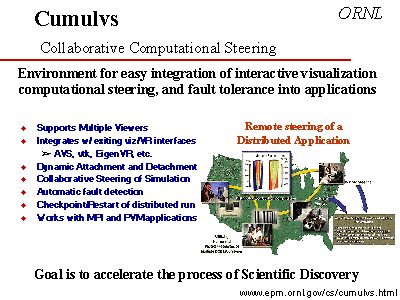
- Supports Multiple Viewers
- Integrates w/ exiting viz/VR interfaces
- AVS, vtk, EigenVR, etc.
- Dynamic Attachment and Detachment
- Collaborative Steering of Simulation
- Automatic fault detection
- Checkpoint/Restart of distributed run
- Works with MPI and PVM applications
- Environment for easy integration of interactive visualization computational steering, and fault tolerance into applications
- Goal is to accelerate the process of Scientific Discovery
- Remote steering of a Distributed Application www.epm.ornl.gov/cs/cumulvs.html
Slide 4 – NetSolve – Client/Server/Agent — Based Computing

- Client-Server design
- Network-enabled solvers
- Seamless access to resources
- Non-hierarchical system
- Load Balancing
- Fault Tolerance
- Heterogeneous Environment Supported
- Easy-to-use tool to provide efficient and uniform access to a variety of scientific packages on UNIX platforms
- NetSolve Client
- NetSolve Agent
- Network Resources
- Software Respository
- Software is available www.cs.utk.edu/netsolve/
Slide 5 – ScaLAPACK – Numerical Linear Algebra Library
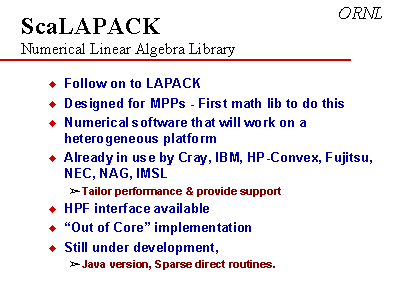
- Follow on to LAPACK
- Designed for MPPs – First math lib to do this
- Numerical software that will work on a heterogeneous platform
- Already in use by Cray, IBM, HP-Convex, Fujitsu, NEC, NAG, IMSL
- Tailor performance & provide support
- HPF interface available
- “Out of Core” implementation
- Still under development,
- Java version, Sparse direct routines.
Slide 6 – ATLAS Project – Automatic Generation of Optimized NLA Kernels
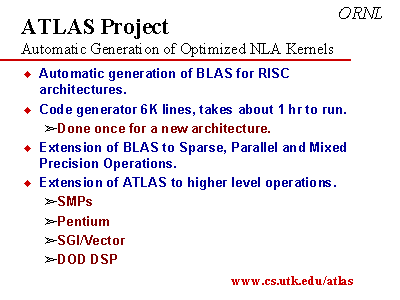
- Automatic generation of BLAS for RISC architectures.
- Code generator 6K lines, takes about 1hr to run.
- Done once for a new architecture.
- Extension of BLAS to Sparse, Parallel and Mixed Precision Operations.
- Extension of ATLAS to higher level operations.
- SMPs
- Pentium
- SGI/Vector
- DOD DSP
- www.cs.utk.edu/atlas
Slide 7
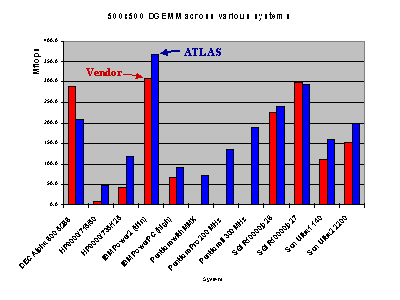
Vendor: ATLAS
Slide 8 – TORC – Tennessee / Oak Ridge Cluster
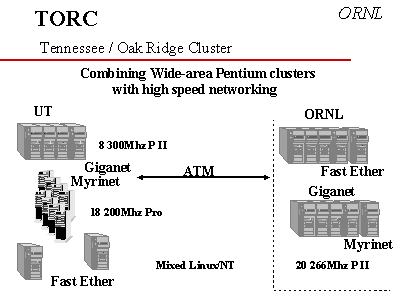
- Tennessee / Oak Ridge Cluster
- Combining Wide-Area Pentium clusters with high-speed networking
- ORNL Myrinet
- 20x 266Mhz Pentium II
- Fast Ether Giganet
- UT
- 8x 300Mhz Pentium II
- Giganet Myrinet
- 18x 200Mhz Pro
- ATM
- Mixed Linux/NT
Slide 9 – PVM 3.4 – Latest Version allows NT and Unix Custering
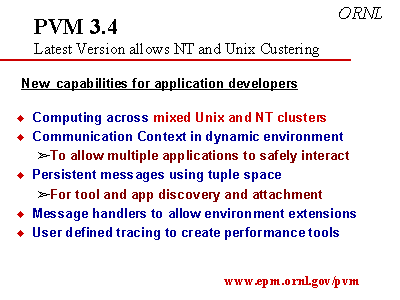
- Computing across mixed Unix and NT clusters
- Communication Context in dynamic environment
- To allow multiple applications to safely interact
- Persistent messages using tuple space
- For tool and app discovery and attachment
- Message handlers to allow environment extensions
- User defined tracing to create performance tools
- www.epm.ornl.gov/pvm
- New capabilities for application developers
Slide 10 – HARNESS – Next Generation beyond PVM
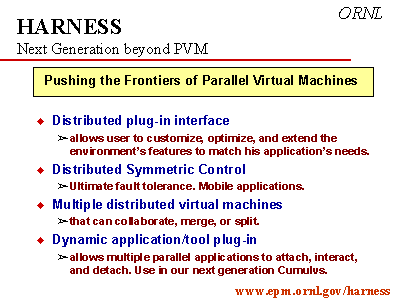
- Distributed plug-in interface
- allows user to customize, optimize, and extend the environmentís features to match his applicationís needs.
- Distributed Symmetric Control
- Ultimate fault tolerance. Mobile applications.
- Multiple distributed virtual machines
- that can collaborate, merge, or split.
- Dynamic application/tool plug-in
- allows multiple parallel applications to attach, interact, and detach. Use in our next generation Cumulvs.
- Pushing the Frontiers of Parallel Virtual Machines
- www.epm.oml.gov/harness
Slide 11

- Generalized
- Plug-in
- Machine
- Multi-level hot-pluggability allows user to adaptability to a dynamic environment
- Harness
- Dynamically adaptable and extensible VM